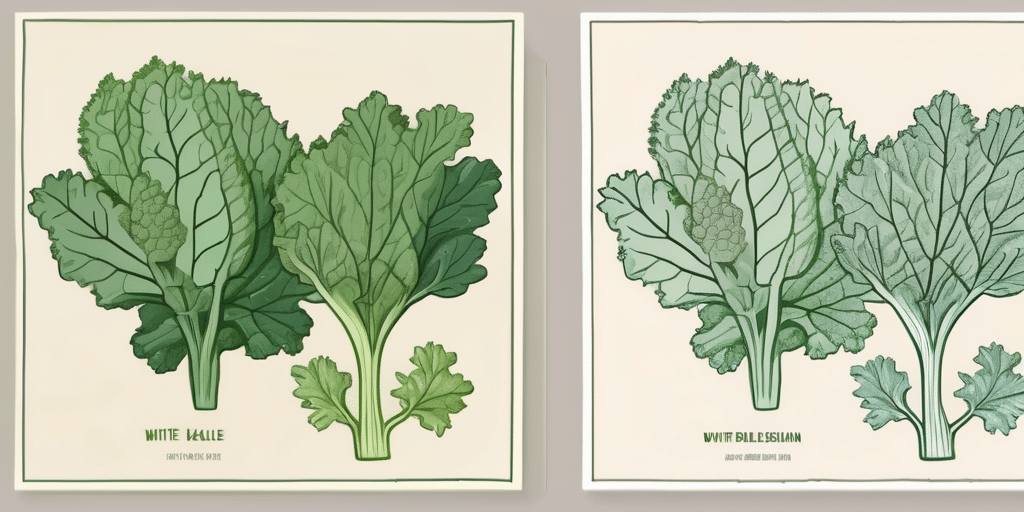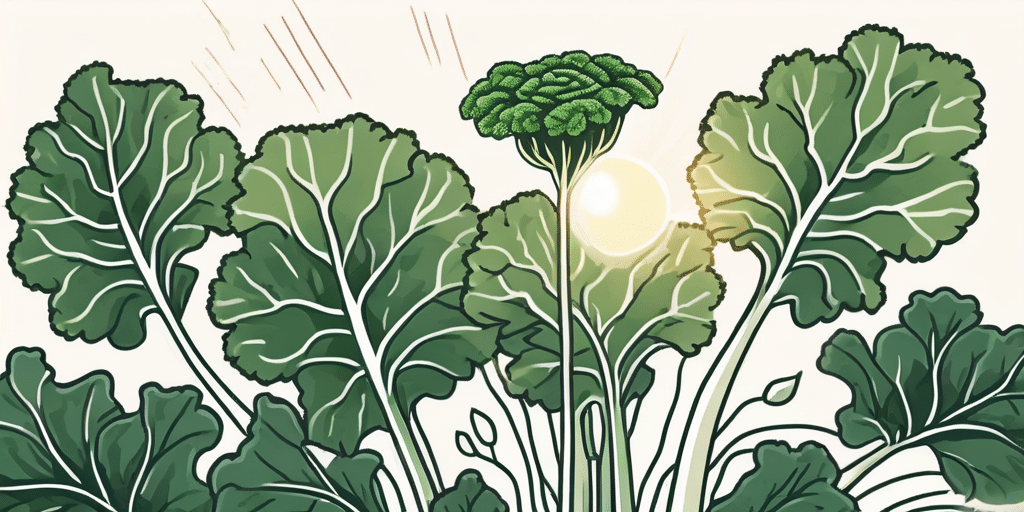Red Russian Kale and Redbor Kale are both popular varieties of kale that are known for their vibrant colors and delicious taste. If you’re a kale lover or someone who wants to add more leafy greens to your diet, you may be wondering which one is the better choice. In this article, we will compare Red Russian Kale and Redbor Kale so you can make an informed decision.
What is Red Russian Kale?
Red Russian Kale, also known as Ragged Jack or Red Russian Kale, is a variety of kale that has deep green leaves with purple veins. It is known for its tender texture and slightly sweet flavor. Red Russian Kale belongs to the Brassica family, which includes other cruciferous vegetables like broccoli and cabbage.
Red Russian Kale is rich in vitamins A, C, and K, as well as antioxidants that promote overall health. It is also a good source of dietary fiber, which aids in digestion and helps maintain a healthy weight.
One interesting fact about Red Russian Kale is that it is believed to have originated in Russia and was introduced to North America in the 19th century. Its unique appearance with vibrant purple veins running through the leaves makes it a visually striking addition to any dish. This variety of kale is versatile and can be enjoyed raw in salads, sautéed with garlic and olive oil, or even blended into smoothies for an added nutritional boost.
In addition to its nutritional benefits, Red Russian Kale is also known for its high levels of lutein and zeaxanthin, two antioxidants that are essential for maintaining eye health. These compounds help protect the eyes from harmful UV rays and reduce the risk of age-related macular degeneration. Including Red Russian Kale in your diet can contribute to better vision and overall eye health.
Pros & Cons of Red Russian Kale
Like any food, Red Russian Kale has its pros and cons. Here are some of the advantages and disadvantages of choosing Red Russian Kale:
Pros:
- High in nutrients: Red Russian Kale is packed with essential vitamins and minerals.
- Tender texture: The leaves of Red Russian Kale are tender and delicious.
- Sweet flavor: Red Russian Kale has a pleasant, slightly sweet flavor that makes it a versatile ingredient in various recipes.
Red Russian Kale is not only a nutritional powerhouse but also a versatile ingredient that can be used in a variety of dishes. Its vibrant green color and delicate texture make it a visually appealing addition to salads, smoothies, soups, and stir-fries. The mild sweetness of Red Russian Kale pairs well with a wide range of flavors, from tangy vinaigrettes to savory spices, enhancing the overall taste of the dish.
Cons:
- Flavor may not appeal to everyone: While many people enjoy the taste of Red Russian Kale, some may find it too strong or bitter.
- Relatively short shelf life: Red Russian Kale is best consumed within a few days of purchase to maintain its freshness and nutritional value.
Despite its numerous benefits, some individuals may find the flavor of Red Russian Kale to be an acquired taste. Its slightly bitter undertones can be off-putting to those who prefer milder greens. Additionally, due to its delicate nature, Red Russian Kale has a shorter shelf life compared to heartier greens like kale, requiring proper storage and prompt consumption to prevent wilting and nutrient loss.
Redbor Kale is not only a nutritional powerhouse but also a stunning addition to any garden. Its vibrant purple-red leaves add a pop of color to your vegetable patch, making it not just a healthy choice but also a visually appealing one. This variety of kale thrives in cooler temperatures, making it a great option for fall and winter harvests.In addition to its impressive nutritional profile, Redbor Kale is also known for its versatility in the kitchen. You can enjoy it raw in salads for a crunchy texture and a slightly peppery flavor, or you can sauté or steam it to soften the leaves and mellow out the taste. Some creative cooks even use Redbor Kale in smoothies or as a colorful garnish for various dishes. Its unique color can elevate the presentation of any meal, making it a favorite among home chefs and food enthusiasts alike.
Pros & Cons of Redbor Kale
Let’s take a look at the advantages and disadvantages of incorporating Redbor Kale into your diet:
Pros:
- Rich in nutrients: Redbor Kale provides a wide range of vitamins, minerals, and antioxidants.
- Eye-catching appearance: The deep purple-red leaves of Redbor Kale add a pop of color to salads and other dishes.
- Health benefits: The glucosinolates found in Redbor Kale have been associated with reducing the risk of chronic diseases.
Cons:
- Strong flavor: The flavor of Redbor Kale is more assertive than other kale varieties, which may not appeal to everyone’s palate.
- Increased cooking time: Due to its thicker leaves, Redbor Kale may require longer cooking times compared to other varieties.
Is Red Russian Kale or Redbor Kale Right for You?
Choosing between Red Russian Kale and Redbor Kale ultimately depends on your personal preferences and dietary needs. Both varieties offer exceptional nutritional benefits and can be enjoyed in a variety of ways.
If you prefer a milder taste and delicate texture, Red Russian Kale may be the better choice for you. On the other hand, if you don’t mind the stronger flavor and want a visually stunning ingredient, Redbor Kale may be the way to go.
It’s worth noting that you can also mix and match these kale varieties in your recipes to enjoy the benefits of both.
Frequently Asked Questions
Q: Can I eat Red Russian Kale or Redbor Kale raw?
A: Yes, both Red Russian Kale and Redbor Kale can be enjoyed raw. However, massaging the leaves with a bit of olive oil or lemon juice helps break down the fibers and makes them more tender.
Q: How should I store Red Russian Kale and Redbor Kale?
A: To keep Red Russian Kale and Redbor Kale fresh, wrap them in a damp paper towel and store them in the refrigerator’s crisper drawer. They should stay fresh for up to a week.
Q: Are Red Russian Kale and Redbor Kale good for weight loss?
A: Yes, both Red Russian Kale and Redbor Kale are low in calories and high in fiber, making them an excellent choice for weight loss and maintaining a healthy weight.
Q: Can I freeze Red Russian Kale or Redbor Kale?
A: Yes, you can freeze both Red Russian Kale and Redbor Kale. Before freezing, blanch the kale leaves in boiling water for 2 minutes, then transfer them to an ice bath. Drain well and store in airtight containers or freezer bags for up to 12 months.
Q: What are some recipe ideas for Red Russian Kale and Redbor Kale?
A: Both Red Russian Kale and Redbor Kale can be used in a variety of recipes. Here are some ideas to get you started:
- Sauté Red Russian Kale with garlic and olive oil for a simple and delicious side dish.
- Add Redbor Kale to smoothies for an extra dose of nutrients and vibrant color.
- Toss Red Russian Kale or Redbor Kale with your favorite salad ingredients for a nutritious and satisfying meal.
- Incorporate Red Russian Kale or Redbor Kale into soups, stews, or pasta dishes for added flavor and texture.
Experiment with different cooking methods and combinations to find your favorite way to enjoy these nutritious and tasty greens!
Join Our Green-Thumbed Community!
Ready to take your kale cultivation to the next level? Subscribe for free to How to Grow Everything and learn how to build the garden of your dreams! Receive personalized gardening advice tailored to your grow zone, experience level, and interests. Enjoy the best gardening tips, special offers, and insights delivered straight to your inbox – with no spam, just valuable knowledge from our family to yours. Join thousands of other gardeners who trust us for their gardening needs. Let’s grow together!






